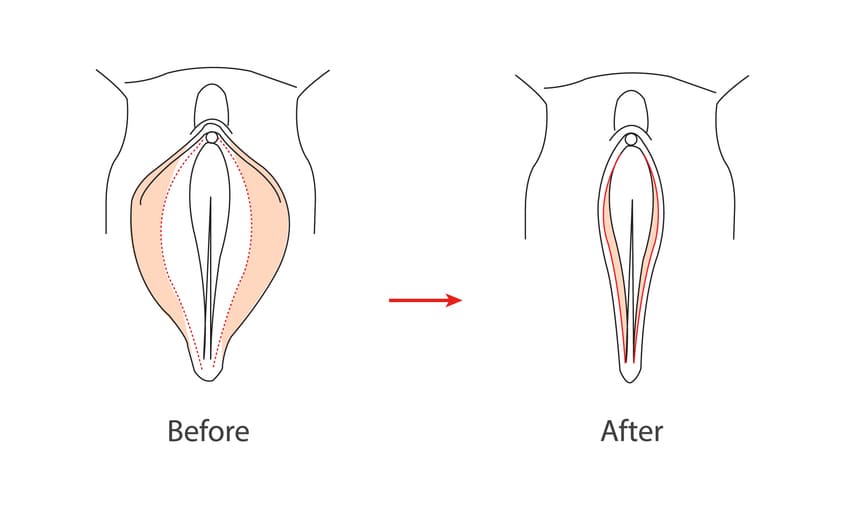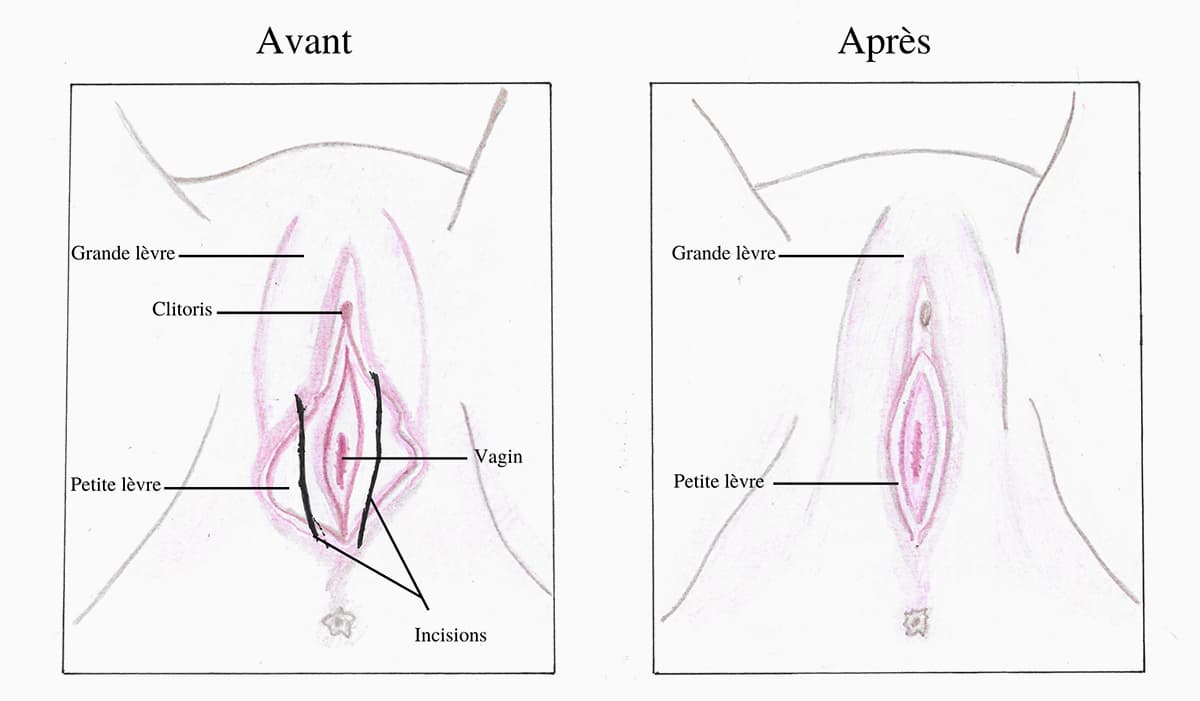What is nymphoplasty?
Nymphoplasty, also known as reduction nymphoplasty, is cosmetic surgery of the labia minora at the level of the female genitalia. Classified as part of cosmetic surgery of the body and more precisely of women's intimate surgeries, nymphoplasty makes it possible to reduce the size of the labia minora so as to harmonize it with the volume of the vulva. This operation uses techniques such as resection.
Objectives of nymphoplasty
Anatomically, the vulvar cleft is made up of two labia minora lined with two labia majora. The main objective pursued by the labia minora reduction nymphoplasty is to treat the hypertrophy of the labia minora. This deformity affects the private parts of women and is characterized by too large a size of the labia minora compared to the labia majora. Indeed, the labia minora take on an abnormal size even exceeding the volume of the vulva in a standing position. It is a deformation that is often accompanied by hyperpigmentation, and generally affects the 2 labia minora (bilateral) but can sometimes be unilateral, that is to say affecting only one labia minora. In summary, nymphoplasty therefore aims to correct and reduce the size of the labia minora in order to restore a harmonious vulva.
Candidates for nymphoplasty
Hypertrophy of the labia minora usually occurs from puberty. It can be observed after maternity or at the time of menopause. Patients who want reduction nymphoplasty generally have at least one of the following disorders, which are often exposed by candidates at Dr. Delobaux's practice. These disorders mainly relate to: Discomfort related to friction or "jamming" of the labia minora, in all the different daily activities. Discomfort in clothing with pain in the labia minora when tight pants or strings are worn. Pain when sports physical exercises, in particular cycling or horse riding, Discomfort during coitus, with pain during penetration by blocking the labia minora Discomfort relating to psychology: shame at being naked in front of one's partner Aesthetic discomfort All these discomforts being legitimate and serious , when one of them is evoked by a patient, the use of nymphoplasty will be justified.
Principles of labiaplasty surgery
The surgical operation consists of subtracting or removing the excess portion of the labia minora, using different techniques such as: The triangular technique: It consists of hiding the scar as much as possible, in order to avoid friction, irritation or scar retraction. The longitudinal technique: This nymphoplasty technique consists of removing the excess lip longitudinally (that is to say all along the lip). The advantage that the triangular technique provides is that it allows more excess lip to be removed, which interests and satisfies many patients. With these “invisible” suturing methods, the scar is completely concealed and invisible. For many years, these techniques of longitudinal or triangular excision have been surgical standards. It is not legitimate to think that there is only one technique as many often mistakenly think, but there are several. You will agree with Doctor Delobaux on the choice of the appropriate technique adapted to your needs and according to the anatomy of your body.
Nymphoplastie or labiaplastie?
Both terms seem to mean the same thing. According to usage and habit, some speak of labiaplasty. But the most commonly used term in scientific circles is nymphoplasty.
Longitudinal nymphoplasty method
This method aims to remove excess mucous along the labia minora. This process offers very good results in cases where the excess labia minora is distributed over the entire length of the lip. Thanks to buried suturing techniques, the scar is completely invisible, and the lip maintains its natural appearance. It is often reported that contact of the scar with underwear can slow healing or even cause pain during intimate intercourse (dyspareunia). This remains purely a belief and not a reality. On the other hand, this so-called longitudinal technique has a major advantage over that of triangular nymphoplasty. The advantage is that the risk of suture release is exceptional. Even assuming that this happens, the consequences are very slight, because the lip will heal spontaneously. The other important advantage is that the reduction of the height of the labia next to the clitoris hood is possible, which the other methods do not allow to do. This technique is very effective, reliable, secure and gives impressive results. It is the first nymphoplasty method proposed by the French Society of Reconstructive and Aesthetic Plastic Surgery.
Triangular or wedge-shaped nymphoplasty method
It aims to remove an excess mucous triangle of labia minora. The mucosal triangle can be removed at different levels of the lip, however, the best triangular method is to remove a triangle on the posterior half of the lip. In this way, the appearance of the folds of the lip is preserved, and the scar is perfectly invisible at the point of junction of the labia majora and the labia minora. The main risk of this technique of nymphoplasty remains the disunity of the scar, with the release of the scar. This problem is seen in a minority of patients (10%) despite appropriate care. This is one of the reasons why this technique is used less by Dr. Delobaux. Posterior triangular nymphoplasty method: the removal of the labia minora triangle is carried out on the posterior half of the lip, and not in the middle. We do not perform the resections of a triangle in the middle of the labia minora, because suture release is frequent due to the difference in thickness of the 2 parts of the lips sutured after removal of the excess. Also, there is often a demarcation between the pink lip in front, and the darker color of the back lip. All these aforementioned risks are relativized in the event of removal of a triangle of mucous membrane behind. This is the only triangular technique that we use, as a second resort in case the longitudinal method does not lend itself to it.
Which nymphoplasty technique to choose?
The choice of technique to use in nymphoplasty is made on a case-by-case basis. However, the longitudinal method is preferred for the quality of its aesthetic results and its reliability with very few risks.
Procedure of the nymphoplasty
To achieve a reduction of the labia minora, several methods exist. Each surgeon therefore has a particular approach that allows him to succeed in his intervention. The goal is to remove excess tissue. Usually, it is an operation which consists of the resection of the labial excess on a case-by-case basis, that is to say personalized and flexible, and based on a scheme defined preoperatively. Thus, hyperpigmentation problems are also solved. In the same way, around the clitoris, the anterior extensions may also be reduced. Doctor Delobaux will complete the operation by placing absorbable sutures and a light dressing. The intervention lasts between 45 minutes to 1 hour. In addition, labia minora surgery can be combined with other surgical procedures. One can cite for example the case of the augmentation of the labia majora.
What happens before the nymphoplasty procedure?
As a general rule, two preoperative consultations are necessary for a nymphoplasty. Medications such as aspirin, anticoagulants, non-steroidal anti-inflammatory drugs which facilitate post-operative bleeding must be stopped 10 days before the operation. Ask for a short period of professional unavailability of about a week depending on the profession.
Hospitalization for nymphoplasty
Hospitalization takes place in a clinic. It is done on an outpatient basis, with the possibility of returning home the same day.
What is the type of anesthesia?
Reduction nymphoplasty usually takes place under general anesthesia. Loco-regional anesthesia (spinal anesthesia) or local anesthesia are also possible, thus avoiding general anesthesia. Local anesthesia is always associated with the lips to reduce postoperative pain.
Post-operative follow-up and advice after nymphoplasty
The aftermath of nymphoplasty surgery is generally very simple. Nymphoplasty is an operation that allows rapid recovery and is most often painless. It requires virtually no work stoppage.
Here are some tips and recommendations for the smooth running of this cosmetic surgery.
Post-operative follow-up of nymphoplasty are immediate at the clinic:
Hospitalization usually only lasts a few hours. The patient is hospitalized in the morning, comes out the same evening (“Day hospital”). However, certain special circumstances may lead the surgeon to propose conventional hospitalization for one night.
The pains often felt are minor, but simple analgesics can relieve them.
Some discreet bleeding can be observed, but without gravity.
A simple intimate protection is sufficient to cover the sutures.
Follow-up and advice the first month after returning home
The consequences are not very painful. On the other hand, there may exceptionally be discomfort when walking in the first few days.
Lips may be slightly swollen. The swelling may be asymmetrical, and if that happens, don't worry. This goes away naturally after the edema subsides.
There is no dressing to do, but a simple toilet with tap water (shower) and soap is sufficient. After each visit to the toilet, it is important to clean the labia minora without rubbing with tap water. It is also important to dry well to avoid maceration. Intimate protection is sufficient to cover the sutures in the event of minor bleeding. Wearing pants is not recommended from the first week, to avoid maceration.
Professional activities can be resumed between 2 and 7 days after surgery.
Postoperative follow-up in 1 month after nymphoplasty
The pain is almost absent. There may be a slight swelling, but without risk because the appearance of the lips is already very much improved. The threads are absorbable and disappear spontaneously in about 2 weeks after the operation. The hygiene measures stated above must be observed. Stopping sports activities for 1 month. Sexual abstinence for 1 month
Post-operative follow-up of nymphoplasty beyond 1 month
If the longitudinal method was used, sexual relations can be resumed 1 month after the nymphoplasty. But in case it is the triangular method that is practiced, sexual intercourse should only be resumed after 6 weeks. The lips regain their fineness between 2 and 3 months after surgery. After 1 month, the scars are generally invisible. They take their final appearance in 1 year. So don't worry if they are sensitive.
What is the result of nymphoplasty?
The result is immediately visible, with a correction of excess labia minora. The pain is very weak or even absent in the majority of the cases of our patients. The final result of the nymphoplasty is seen at 3 months, when the edema will have disappeared, and the labia minora will have regained their finesse and flexibility. Intercourse with coitus is allowed after a month and is not painful. Scarring evolves normally like any other scar on the body and lasts at least 6 to 12 months, with a phase of redness and initial induration of the scar lasting 2 to 3 months. On the other hand, at the level of the mucous membranes of the vulva, healing is most often rapid and excellent, with scars not visible after 1 to 2 months.
Price of nymphoplasty and treatment
The price of nymphoplasty depends on whether or not it is covered by social security. Labia minora surgery is partially covered by social security, with no restriction criteria. The rest is covered by your health insurance fund, depending on the qualitative nature of your contract.
Risks of nymphoplasty
Complications of nymphoplasty are fortunately very rare. Patients in the vast majority of cases are very satisfied with the result obtained. Nevertheless, as no human work is perfect, certain complications are unpredictable, and can occur even when the surgeon would present all the skills required for the exercise of plastic, reconstructive and aesthetic surgery. General complications of nymphoplasty: Risks relating to general anesthesia, Hematomas likely to lead to another intervention Rare infections of the operating site, and prevented by good hygiene and local care, in particular after each urination. Complications specific to nymphoplasty: Sensitivity disorders of the operated area are possible, such as insensitivity or hypersensitivity. They may be associated with pain due to pressure from the scarred area. These symptoms last only a short time and disappear a few months after nymphoplasty. Healing disorders can be seen. This is the case with large, hypertrophic or keloid scars. It is actually more or less complete disunity of the sutures, which constitutes a major specific complication. In this case, another surgery will be scheduled, after complete healing of the disunity. Sexual intercourse can be exceptionally painful but these pains last only a short time.
Get an appointment
All interventions







